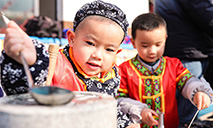Yearender: What an unusual 2021 says about the future of China's economy


Workers assemble new energy vehicles at an automobile company in Liuzhou, south China's Guangxi Zhuang Autonomous Region, Aug. 12, 2021. Xinhua's top 10 China news events in 2021 (Photo by Li Hanchi/Xinhua)
BEIJING, Dec. 30 (Xinhua) -- In a year highlighted by unexpected disruptions and mounting uncertainties, China is set to secure stable growth with the help of its swift policy response.
The world's second-largest economy expanded 9.8 percent year on year in the first three quarters, a hard-won result amid various challenges including pandemic resurgences and mounting debt pressures, reflecting the effectiveness of policies to support growth while defusing risks.
For the full year, the World Bank projected that China's economy would grow 8 percent, higher than the government target of "above 6 percent."
A review of the government's fine-tuned policymaking in 2021 gives a glimpse into how China addressed the common challenges facing the global economy and what that means for the year 2022 and beyond.
PRECISE PANDEMIC CONTROL
Two years into the pandemic, global policymakers are still trying to find the best way to balance growth with pandemic control.
China has adopted stringent pandemic control policies in 2021, wiping out new outbreaks as soon as possible with early detection, swift response, targeted containment, and effective treatment of COVID-19 patients.
Such policies have proved effective not only in ensuring public health, but also in an economic sense as the gains from normalized production and consumption outweigh pandemic control costs, analysts said.
"Overall the policies have brought significant benefits. Thanks to the policies, the growth rate of the Chinese economy outpaced the majority of other economies for the past year," said Lu Ting, chief China economist with securities firm Nomura.
Next year, striking a balance between precise pandemic control and economic growth will be increasingly critical, Lu said.
While COVID-19 has brought disruptions to consumption, the impact will be mitigated by the "learning effect," reflected in strengthened government capabilities in precisely containing COVID-19 and improving people's willingness to consume offline, the China International Capital Corporation (CICC) said in a report.
"For 2022, we should not be overly pessimistic about the possible impact from COVID-19. We expect household consumption to mildly recover thanks to pro-growth policies," CICC said.
TARGETED CREDIT SUPPORT
Another challenge facing global policymakers in 2021 is how to provide much-needed credit support to the COVID-battered economy without adding excessive debt.
Instead of printing money and pumping cash into the whole financial system, China has adopted a prudent monetary policy in 2021, channeling funds through targeted monetary tools to specific sectors such as manufacturing as well as the more vulnerable small and medium-sized companies.
The country's central bank has cut the reserve requirement ratio (RRR) for financial institutions twice this year to offer liquidity to the real economy.
In addition, the country has been more proactive in taking fiscal measures to shore up growth, cutting taxes and fees for companies while transferring central funds to support regions hit by natural disasters.
On the other hand, the country has remained cautious in channeling funds to the housing sector, continuing its deleveraging campaign that has been going on for years under the principle of "housing is for living in, not for speculation."
In its latest effort to bolster the real economy, the country cut the one-year market-based benchmark lending rate by 5 basis points in December but kept unchanged the over-five-year benchmark rate, on which many lenders base their mortgage rates.
The recent cuts in the reserve requirement ratio and lending rate signal a more accommodative monetary policy stance, although financial sector de-risking efforts are expected to continue, the World Bank said in a report.
In 2022, China will continue implementing proactive fiscal policies and prudent monetary policies, the tone-setting Central Economic Work Conference decided, adding that the country will boost the virtuous cycle and healthy development of the property sector with city-specific policies.
ORDERLY GREEN TRANSITION
Despite mounting growth pressure, China has been steadily pushing its carbon peaking and carbon neutral agenda with institutional innovations in 2021.
As a market-based mechanism to incentivize carbon emission cuts by companies, a national carbon market started trading in July, which has seen active trading of carbon emission quotas.
While encouraging the use of green energy, policymakers have paid special attention to the potential disruption to the energy supply and economic activity, reiterating that local governments should avoid "campaign-style" carbon reduction.
"Achieving carbon peaking and carbon neutrality is an inherent requirement for promoting high-quality development, which requires unswerving efforts. It is impossible to achieve the goal all at once," the Central Economic Work Conference said.
To ensure a smooth transition toward low-carbon development, China has been stepping up investment in green technologies, and creating opportunities for both domestic and foreign companies.
Under the carbon goals, investment into the green manufacturing sector will see notable growth for the next year, especially sectors including pollution control, the digital economy as well as new energy and materials, said the Bank of Communications in a report.
Investment in these areas will stimulate short-term demand and aid China in transitioning to new growth engines in the long term, the report said.
Photos
Related Stories
Copyright © 2021 People's Daily Online. All Rights Reserved.










